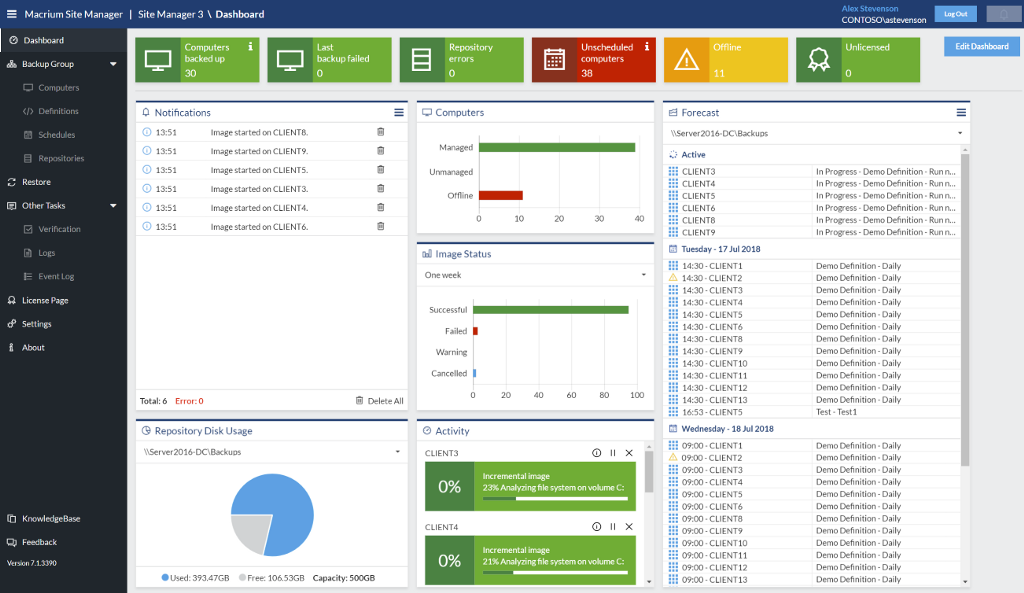Site Manager Update


With a new release of Site Manager comes a variety of new features. Today we will be discussing some of these in more detail, so that you can get the most out of this new update.
Scheduled Activity
The new ‘Scheduled Activity’ tab in Site Manager allows for all activity (backups and remote syncs) to be scheduled in one convenient location, with a new UI that makes it easy to see the information that matters most.
In this tab, you will be able to view all the repositories that you have configured. Below the repository, you will see all backups that are scheduled to use that repository as a destination, these scheduled backups can appear as four colours:
Green — This indicates that is are no fails or warnings for this scheduled backup.
Yellow — This indicates that there is at least one warning for the scheduled backup, but no failures.
Red — This indicates that there is at least one failed backup for the scheduled backup.
Grey — This indicates that the scheduled backup has been disabled. This is done with the toggle switch next to ‘Run Now’.

Below the scheduled backups, you have the ‘Schedule Backup’ option. This allows you to schedule a backup for the repository you selected this under. In the wizard that opens, you can select the ‘Definition’ and ‘Schedule’ that you want to use for this backup schedule.

For more information on scheduling a backup using Site Manager, please see the following blog post:
How to schedule a backup using Site Manager
Under the ‘Schedule Backup’ option, is the remote sync. If you have configured a sync for the repository, then you will see detailed statistics for the sync.

If you have not configured a sync, then it will show ‘No Remote Sync’, selecting this will present the ‘Configure Synchronization’ button, selecting this will open the ‘Schedule Activity’ wizard, allowing you to easily configure a sync. Once a remote sync has been configured, it will be displayed as one of three colours:
Green — the last performed sync was successful
Red — the last performed sync failed (includes cancelled).
Grey — the sync is not set up.
Repository Page
With the scheduling of backups being moved to the ‘Scheduled Activity’ page, the Repository page has been redesigned to focus on repository status and browsing.

File and Folder Backups
A feature that has often been requested is the ability to perform File and Folder backups from the Site Manager.

To schedule a File and Folder backup using Site Manager, navigate to the ‘Definitions’ tab and select ‘New Definition’. Once you have selected ‘Files and Folders’ you can then create a name and description.
On the ‘Computers’ page of the wizard, select the computers that you want to be included in the scheduled backup.

On the next page of the wizard, select ‘Add Folder’ and add the UNC path. You then have extra options that allows you to define ‘Files to include’, ‘Files to exclude’ and ‘Folders to exclude’.

Once you are finished, the rules that you have defined will be shown in the wizard.

On the final page of the wizard, you can select additional options for the backup:
Compression — This applies a level of compression to your backup.
Encryption — This allows you to specify which level of AES encryption and password you want to apply to your backup file (if any).
Verification — When verification is enabled the entire backup will be checked to ensure the integrity of the data inside.
Comment — This allows you to add an additional comment to any backup file that is created by this definition.
More information about these options can be found in the knowledgebase article linked below:
Once the backup definition has been created, navigate to the ‘Scheduled Activity’ tab, then select ‘Schedule Backup’ under the repository you want to use as a destination. You can then select this definition and a schedule for how often the backup should be performed.

You have now scheduled a file and folder backup. Once you have created a file and folder backup it can be opened and verified in the same way as a disk image and will appear in the same interface when browsing a repository.

Note: File and Folder backups cannot be restored using Site Manager and can only be restored using the Agent.
Multiple File and Folder downloads
When browsing image files, it is now possible to download multiple files and folders as a single ZIP file. This can be done by selecting the ‘Repositories’ page in Site Manager and then selecting the repository that contains the backup you want to browse. Once you have selected the repository, select ‘Browse’ and then select the relevant image file.

Once you have selected ‘Open Image’, you will be presented with the ‘Image Browser’. This will allow you to select a partition that is included in the image. You can then select multiple files to download and select ‘Download’.

This will download all the select files as a ZIP file.
Backups During Remote Synchronisation
When configuring or editing a sync, you now have the option to ‘Allow Backup During Remote Synchronisation’.

The process for performing a backup during the remote sync is shown below:
1) The remote sync can only start when no backups are running — this is so that there is a consistent, point in time view of which backups exist.
2) The sync process will find changes and data to upload and sort them by computer.
3) Changes are uploaded for the computer with the smallest amount of data to upload.
4) The computer from step 3 is ‘unlocked’ and backups for this computer may now start, this will only occur once all the data has been transferred for this computer.
5) Steps 3 and 4 are repeated until all data is uploaded.
6) The change is committed in the remote location. Before this step, if the sync fails, the changes can be rolled back to the previous repository state.
Quiet Install
The ability to perform a ‘Quiet Install’ has now been added when manually installing Macrium Agent. This is useful when you are unable to perform a remote install of Macrium Remote Agent, but still want it installed without the desktop and start menu shortcuts. More information about performing a manual install can be found at the knowledgebase article below:
https://knowledgebase.macrium.com/display/MSM/Agent+Manual+Install

For more detailed information about these changes, and information about fixes and changes to existing features, please view the Macrium Site Manager Knowledgebase shown below:
https://knowledgebase.macrium.com/display/MSM/
Contact us for more information, for a demonstration,
or download a trial of Site Manager.


